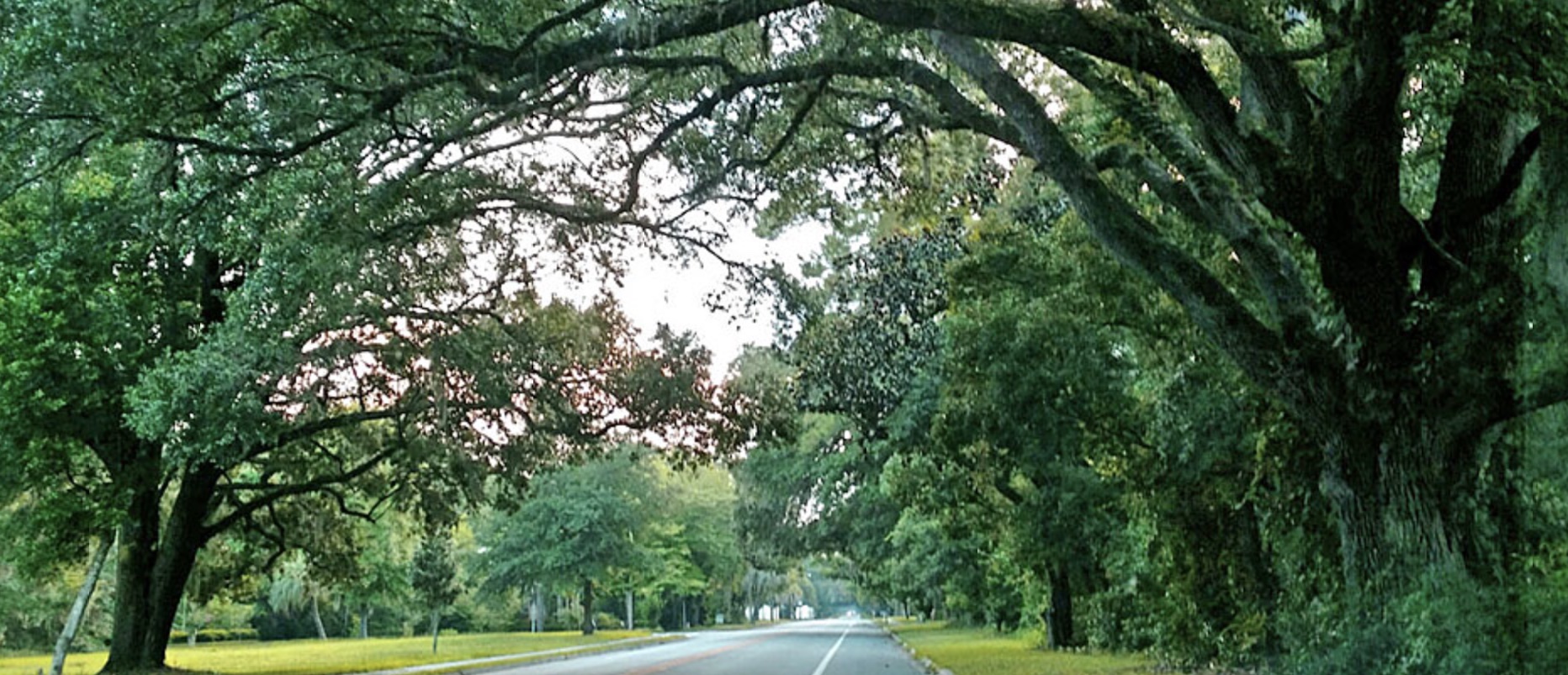The portion of S.R. 16 (James C. Penney Memorial Boulevard) that is being proposed as a Florida Scenic Highway (J.C. Penney Memorial Scenic Highway) is a nearly 3-mile section of the highway that runs the length of the Town of Penney Farms and is bordered by magnolia and live oak trees, some of which date at least from the period of James C. Penney's purchase. This canopy of majestic and sometimes colorful trees provides attractive borders to James C. Penney Memorial Boulevard.
The remaining portion of the proposed J.C. Penney Memorial Scenic Highway loops through the Town of Penney Farms on local streets. The Town of Penney Farms has within its bounds two distinctive historically significant communities - the Penney Retirement Community and New Hope. The Penney Retirement Community is a result of the legacy of James Cash Penney, a son of the Midwest state of Missouri. He grew up with at least two important influences in his early life; the hard work of a farming family and the moral influence of parents engaged in what could be called a tent ministry - the parents earning their living by farming the land and ministering in a Primitive Baptist Church. James C. Penney never lost his love of farming, though he was to become the founder of what is today one of the most recognized retail chain store names in America. His respect for his parents and their teaching led eventually to sound business practices and to a socially conscious personal lifestyle.
The name James C. Penney recalls a defining moment in the development of the Penney Farms communities, when this nationally known retailer, in the 1920's, became involved in Florida's First Coast. James C. Penney did so with the purchase of 120,000 acres of land for the price of $400,000. His initial acreage stretched from the St. Johns River town of Green Cove Springs in the east, to Starke in the west. He organized a national campaign to attract farmers to northeastern Florida, and established a retirement community initially known as the Memorial Home, in memory of his parents. This retirement facility originally dedicated to providing a residence for retired ministers, missionaries, and YMCA workers, was subsequently renamed Penney Retirement Community, in 1971. At this time, non-clergy laypersons were invited to join. Today the community has no connection with the J.C. Penney Company, and is an officially registered non-profit organization with its own Board of Directors.
The inhospitable soils, as well as Penney's finances during the 1929 Depression and its aftermath, were factors contributing to the agricultural project's demise. The Memorial Home reorganized and operated by the Christian Herald for a number of years before becoming self-sustaining. Penney's initial gift of the Penney Memorial Church and the original cottages in the central campus, have been a focal point over the years. The Penney Retirement Community celebrated its 80th Anniversary in 2006.
Some of the original memorial homes built and paid for by James C. Penney are located on Poling Boulevard within the Penney Retirement Community. The name Poling recalls one of James C. Penney's most important friends and collaborators over many years, Reverend Dr. Daniel A. Poling. The latter wore many hats, but one of the most important was as the editor of an interdenominational publication, The Christian Herald. Dr. Poling assumed for a period of almost 30 years, the management board of the Community, supported by a board in New York City. The Penney Memorial Church was dedicated in 1926, and is today recognized as a notable building within a designated National Historic District. A plaque inside the church marks the dedication of the Memorial Home Community in memory of Penney's parents. On the east side of the sanctuary in the church lecture room, there are many pictures of James C. Penney, his parents, Reverend Dr. Daniel A. Poling, and Mrs. James C. Penney.
Some families in the Penney Farms area can trace their roots in Clay County, to what was known as Long Branch City, before the Town of Penney Farms was incorporated in 1927. Especially after the Civil War, settlers, both white and African-American, had moved south into northeastern Florida and Clay County from Georgia and the Carolinas. They came as farmers and cattle raisers. Some became active in the lumber and turpentine industries. These industries gave productive labor to the early settlers, both white and African-American. Some such settlements predated the Civil War, a conflict that found northern Florida serving as a breadbasket for the Confederacy. At least two streams of immigration occurred into northern Florida during the post Civil War period. White and African-American immigrants to Florida after the Civil War found a still largely undeveloped frontier. Mostly white farmers from Georgia, Alabama, and the Carolinas, came with livestock, farming implements, and household goods. Their pride, pluck, and gritty self-reliance characterized their culture. The increase in black residents during this period raised their proportion of the population to 47 percent. In their new status as freemen, many sought employment as laborers on the plantations. In the mid-1920s, some residents did agriculture work for James C. Penney. There is a former dwelling in Penney Farms that is identified as a tenant farmer cottage, one of several originally built. Its historical preservation is currently being aggressively explored by the CASH-16 and the Historical Society of Penney Farms.
Local farming and cattle-raising families, tracing their history back multiple generations before James C. Penney, can recall the introduction of the lumber and turpentine industry in the Penney Farms area.
Byway Description

The J.C. Penney Memorial Scenic Highway passes through a series of natural and majestic features, including oak and magnolia canopies, and a variety of bottomland hardwoods, commercial forest, mesic hammock, and wetlands landscapes. The corridor allows travelers to experience Penney Farms community by experiencing its cultural, historical, and scenic resources, such as Penney Memorial Church, Penney Retirement Community's French Norman architecture, and the New Hope community.
The J.C. Penney Memorial Scenic Highway is a unique area for tourists and visitors to walk or ride a bike along the scenic highway to view Penney Farms' natural and historical resources and the oasis "garden spot" within the community.
